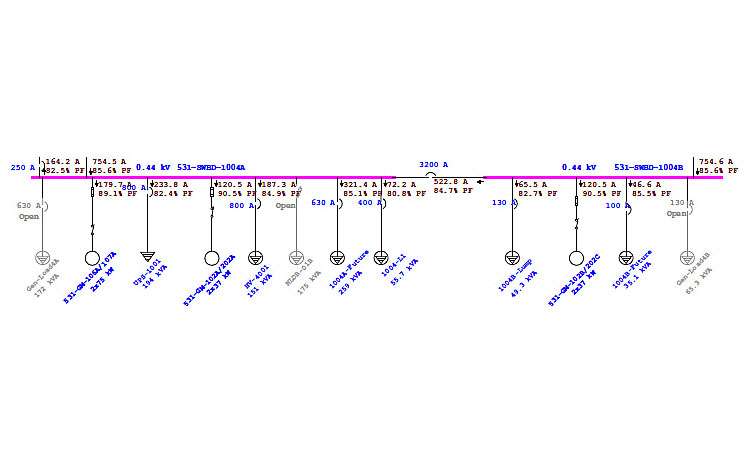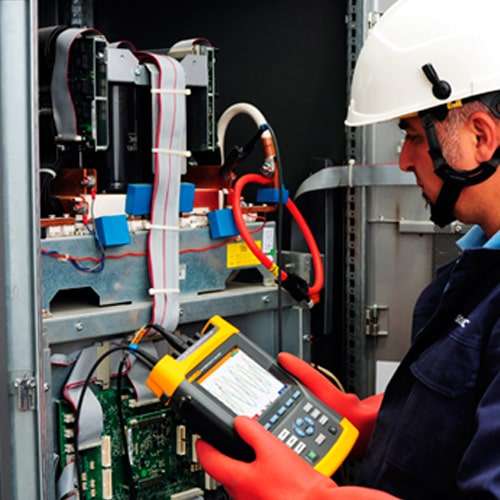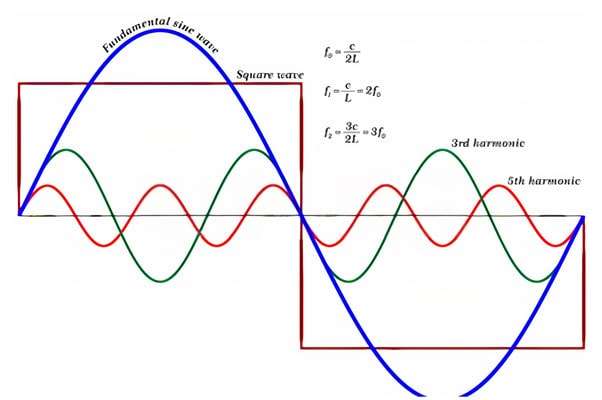Load Flow, Short Circuit, and Relay Coordination in Power System Analysis
A power system analysis comprises a number of technical evaluations as well as the use of scientific analytical ideas and techniques to verify that your facility’s power system is safe, effective, and reliable under both normal and unforeseen conditions. The objective of a power system analysis is to comprehend how a system will act in different configurations and how disturbances, such as capacitor switching, the start of a big motor, and arc flash energy, would affect it. To that safety equipment performs effectively in the event of a short circuit or other failure, it may be necessary to conduct an examination of the power system. Power systems must be researched to provide a continuous and reliable electrical supply. A power system that is well-designed assures dependable operation and maximizes plant utilization in all operational conditions. Poorly constructed systems are marked by outages, defects, inefficiency, and diminished security.
The following small studies may be included in a study of a typical power system:
- Analysis and research on load flow
- Short circuits are examined and explored.
- A study of how relays communicate with one another.
- Arc Flash Danger Research and Analysis
- Harmonics studies
- Change and movement analysis
- Earth science studies
This blog will examine the first three studies. and comprehend the applicable regulations and procedures for each of these queries.
Load Flow Investigation and Analysis:
A load flow study investigates an electrical network to ascertain the flow direction of power. It helps determine the efficiency of the power system and the amount of active and reactive power generated, as well as losses, voltage, current, and power factor.
The load flow study included three components:
- Modelling of power system networks and components
- The method for generating load flow equations.
- Using mathematics to solve the equations that explain the relationship between load and flow.
There are three ways to determine power system information:
- The Gauss-Seidel System is a prominent data analysis technique. This method has the benefits of being easy to implement, requiring little computer resources, and finishing the work rapidly. However, because of the delayed convergence, further processes are necessary. The quantity of iterations increases along with the number of buses.
- The Newton-Raphson method is more complex and utilizes quadratic convergence, which is advantageous in difficult-to-understand situations. Because it needs fewer repetitions to obtain convergence, this strategy utilizes less computer resources. It is even more accurate since regulating transformers and slack bus selection have less of an impact. Programming may be challenging and needs a great deal of computer memory, which is a downside.
- The Fast Decoupled Load Flow System is another way for load flow analysis (FDLF (Fast Decoupled Load Flow)). The primary benefit of this method is its reduced memory requirements. It is widely used instead of the Newton-Raphson method for real-time power grid management since it is five times faster at doing computations. This application can only be utilized under certain conditions. In the power industry, it is thus more difficult to change it to account for considerations like flow or system protection.
Short Circuit Investigation and Analysis:
A short circuit analysis will examine one or more of the following types of short circuits:
- Line-to-line faults arise when two phases simultaneously short out.
- A single line-to-ground failure affects the ground via only one phase.
- When both phases and the ground are shorted simultaneously, a double line-to-ground fault occurs.
In the case of a three-phase defect, there is a short between all three phases. Creating a one-line diagram of the power distribution system will be simple after the sort of problem has been determined. Utilize the created single-line diagram and an impedance diagram with numerical values for the utility source, transformer, and conductor in relation to the voltage that each section may consume to calculate short circuits. It is possible to determine the short circuit current, transformer multiplier, and full-load amps. It is essential to compare the findings to the equipment ratings to ensure that the power distribution system has the necessary safety measures in place at various places to prevent accidents and downtime.
Consideration of Relay Coordination:
Relay coordination is a crucial part of power system safety design because coordination systems guarantee that relays operate quickly, reliably, and selectively to isolating the problem. Coordination analysis is utilized to calculate the number of overcurrent protection devices needed in a power system. It also helps determine the requirements, arrangements, and sizes necessary to achieve a compromise between ensuring equipment safety and limiting system operation.
Using software like ETAP (Electrical Transient Analysis Program), designed to simulate the power system, data collection activities are done. After a short circuit analysis is performed, the fault currents at each electrical location are measured. The protective devices are then selected and configured to limit the impact of equipment failures inside the system. The time-current characteristic curves of the protective device are monitored and compared to detect locations where coordination has failed. Adjustments are made as necessary to ensure that protective devices function consistently and selectively.
Among the Benefits of Power System Analysis Are:
- The power infrastructure has been improved.
- Utilizing the correct equipment with the correct power rating.
- Electrical hazards will be safer and less hazardous.
- Adhere to all applicable laws and electrical installation specifications.
- The proposal of many strategies to enhance the performance and dependability of the system.
- For any upcoming inspections, a record of how the power system is now working is maintained.
CareLabs offers Load Flow analysis, Short Circuit analysis, and Relay coordination analysis to monitor the voltage at various buses as well as the actual and reactive power flow between buses, analyze the system under various fault conditions, and determine how well the system handles small and momentous changes. If your firm in Italy need a power system audit, please contact us, or get a quote. One of our customer service specialists will call you within 24 hours.
Share Post
Related Posts
-
How to Conduct Power Quality Analysis in Italy
-
Power Quality Working Principles in Italy
-
The Importance of Load Flow and Short Circuit Analysis for a Italian Business
-
Test and Verify Electrical Motor Efficiency in accordance with Italian Guidelines
-
How to evaluate efficiency and dependability of commercial motors?
-
Arc Flash Analysis in Italy: A Detailed Guide
-
Load Flow, Short Circuit, and Relay Coordination in Power System Analysis
-
Why Is Harmonic Analysis and Research Important for Italian Businesses?
-
Arc Flash Risk Evaluation and Mitigation Are Essential
-
Harmonic Examination of the Italian Power System






